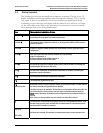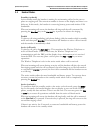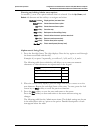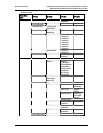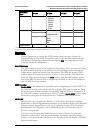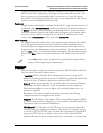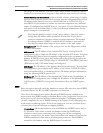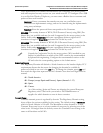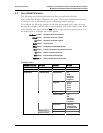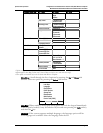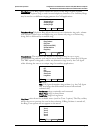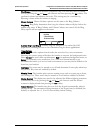
SpectraLink Corporation Configuration and Administration—NetLink e340/i640 Wireless Telephone
Mitel Networks 3300 and SX-200 ICP and 5220 IP Phone emulation
into range of your network. This check takes only a second and ensures that all
handsets in your network are kept up-to-date with the same version of software.
Default Gateway and Subnet Mask: Used to identify subnets, when using a complex
network which includes routers. Both of these must be configured either with an
IP address under Static IP (not set to 000.000.000.000 or 255.255.255.255) or
with DHCP for the handset to contact any network components on a different
subnet. If configured on the DHCP server, use option 3 for the Default Gateway
and option 1 for the Subnet Mask. Contact your network administrator for the
proper settings for your network.
Note that the handsets cannot “roam” across subnets, since they cannot
change their IP address while operational. Ensure that all your access
points are attached to the same subnet for proper operation. The handset
can change subnets if DHCP is enabled and the handset is powered off
then back on when within range of access points on the new subnet.
Syslog Server IP: The IP address of the syslog server. See the Diagnostics section
for more information.
SVP Server IP: The IP address of the NetLink SVP Server. If using Static IP
configuration, this is simply the IP address of the NetLink SVP Server. Note that
the NetLink SVP Server must be statically configured to have a permanent IP
address. If DHCP is being used, the handset will try the following, in order: the
DHCP option 151, then a DNS lookup of “SLNKSVP2” if the DHCP options 6
(DNS Server) and 15 (Domain Name) are configured.
RTC IP Addr: The IP address of the primary Mitel Networks device. If using Static
IP configuration, this is simply the IP address of the device. If DHCP is being
used, the handset will try to obtain the device’s IP address and port information
using the following DHCP options: 129.
OAI Server IP: The IP address of the SpectraLink OAI Gateway (if applicable). If
using Static IP configuration, this is simply the IP address of the SpectraLink
OAI Gateway. If DHCP is being used, the handset will try the DHCP option
152.
ESSID
Select the option that will enable the handset to acquire APs with the correct ESSID
(Extended Service Set ID, aka SSID) each time it is turned on.
Note about Automatic Learn options: Broadcast ESSID must be enabled in the
access points for ESSID learning to function. Refer to the Configuration Note for your
access point or call your access point vendor for specifics. Overlapping wireless
systems complicate the use of ESSID learning as the handset in an overlapping area
could receive conflicting signals. If this is the situation at your site, use Static Entry
or Learn Once in an area without overlapping ESSIDs.
* Learn Once: Allows the handset to scan all ESSIDs for a DHCP server and/or
TFTP server. Once either is found, the handset retains the ESSID from
whichever access point it associates with at that point. When overlapping
wireless systems exist, the Learn Once feature allows the handset to use only the
ESSID established at first learn at all subsequent power ons. This ESSID is
retained by the handset until the ESSID option is reselected.
PN: 72-1084-02-E.doc Page 21



